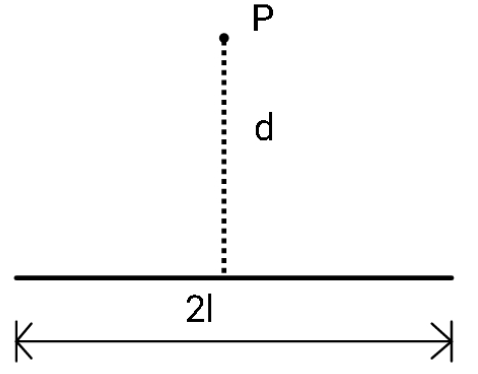Question
Question: A charge q is uniformly distributed along an insulating straight wire of length 2l as shown in fig. ...
A charge q is uniformly distributed along an insulating straight wire of length 2l as shown in fig. Find the expression for electric potential at a point located at a distance d from the distribution along its perpendicular bisector:

A. V=4πϵ01.lqln(l2+d2−ll2+d2+l)
B. V=4πϵ01.2lqln(l2+d2+ll2+d2−l)
C. V=4πϵ01.2lqln(l2+d2−ll2+d2+l)
D. V=4πϵ01.4lqln(l2+d2−ll2+d2+l)
Solution
Start by writing down the potential due to a point charge. Integration on the line charge has to be performed in order to know the potential at point P. So, pick an element of the wire (dx) and find its potential just like the potential for a point charge.
Formula used:
The potential at a distance r from a point charge q is given as:
V=4πϵ01rq.
Complete step-by-step solution:
dV=4πϵ01rλdx .
Notice that the charge of the element is λ dx (as density times length is a charge).
Now, the distance of this element from P (hypotenuse) can be written as:

r=d2+x2
(from Pythagoras theorem).
Substituting the value of r and integrating on both sides we get:
V=4πϵ0λ∫−l+ld2+x2dx
For there types of integrals, we use the formula for special integrals and obtain the result as:
V=4πϵ0λ[ln(x+d2+x2)]−l+l
Substituting the limits in place of x gives us:
V=4πϵ0λln[−l+d2+l2l+d2+l2]
As we used the formula
lnm−lnn=lnnm .
Now upon substituting the value of λ we see our required expression as:
V=4πϵ01.2lqln[d2+l2−ld2+l2+l]
Therefore, the correct answer is option (C).
Note: We performed integration from -l to +l assuming that the center of the wire is placed at the origin. As the length of the wire is 2l, the wire must extend +l along the +x direction and -l along the x-direction.
